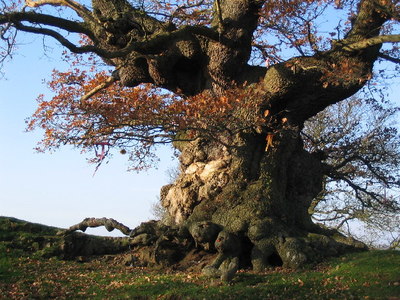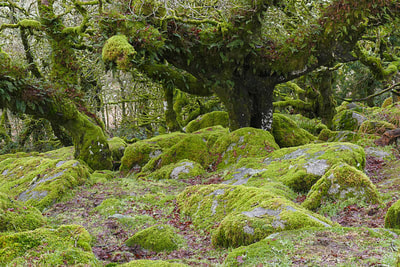The Oak Tree- King of the woodsQuercus robur( pendunculate oak ) Quercus petraea ( sessile oak ) Duir ( Ogham name)
Higher than bushes is Oak. Highest of bushes and a third. Kneeling work, bright and shining work. Craft work. Book of Ballymote 1391 The oak is a tree that has survived well since it regenerated in early wildwood times. It was avoided by the first farmers and encouraged by the early carpenters; no other tree in Britain has captured the imagination and attention of mankind more than the oak. Its timber is durable and good to work with and it has many medicinal qualities and useful tannins. The oak support countless wildlife and grows to impressive proportions, living for many hundreds of years. Its success is partly due to mankind’s love of its timber and its ability to capture the nation’s heart. There are two species of Oak which were first recognised in 1586-7 although this was not really taken on board by British botanists until the 1790s. Quercus robur (Pedunculate oak) is what we think of as the English Oak with its wide and rustic appearance. It has a dense canopy and rough un-stalked leaves with stalked acorns. Quercus petraea ( Sessile oak) is often a taller more stately tree with a more open canopy and flat palmate leaves which are stalked and it bears un-stalked acorns. Both these trees can hybridise and cause even more confusion. Both oaks are known to produce Lammas shoots which are healthy erect shoots that grow strongly in August at a time when other foliage maybe struggling in this sometimes dry time of the year. There is a striking rare variety of Pedunculate oak which produces red Lammas shoots. Sessile oak is more common in the west and north, most commonly growing in the Scottish highlands. Pure oak wood generally grows on the most acid of woodland soils although it is known to grow on calcareous soils in Scotland where it is much more widespread. Hatfield Forest in Essex is an exception as it is an ancient oakwood on calcareous soil outside of Scotland. Oak is generally a first coloniser not growing well in shade. It is not so much birch and hawthorn grow first on oakwood regeneration sites but just quicker thus deceiving the avid naturalist who assumes they came first! In the Doomsday Book woods were assessed by pannage although this practice died out soon after as farmers began to feed pigs in more conventional ways. Beech mast was also used for pannage. The Anglo- Saxon phrase ac means oak and can be noticed in many place names such as Accrington, Auckland and Acton. The traditions of Oak are numerous; from Christian lore the tree has been used to preach under and a place where Angels have appeared. In Celtic lore it is the abode of strong male deities such as the Dagdha, Herne the Hunter, Cernunnos and the archetypal images of the spirit of the trees such as the Green Man or Green George. It is said to be a channel for the might of the sky gods such as Taranis, Thunor, Esus and Thor as it attracts lightning. Merlin and Robin Hood were said to have been protected under the oak’s canopy. St Brigit founded a retreat in Kildare called the Cell of Oak and it is said that the Nuns used acorns as fuel on their fires. Charles the second hid in an oak after defeat at the battle of Worcester on the 29th May 1651 which is now known as Royal Oak Day. At one time Oak sprigs were collected for hats and door knockers which may well be a continuation of the Druidic Oak apple day still celebrated in Wiltshire. The Oak Man, Jack in the Green or the May King dance through the streets wreathed in oak and hawthorn to claim the May Queen. Traditionally the Oak King Giant fights the Holly King Giant at the Winter Solstice making him the King of the waxing year and the two oak trees, Gog and Magog at Glastonbury are said to be the last two giants to have inhabited Britain. Oak bark is used for diarrhoea, piles, inflammations of the throat, chilblains and frost bite. As a powder it is used for nosebleeds and bedsores. Bruised oak leaves can be applied to wounds to ease inflammations and as a mild antiseptic. Please see a medical herbalist if you wish to use oak as a medicine! For a more detailed exploration you may wish to explore our Tree Folklore Course and support valuable Conservation work.
2 Comments
|
Details
Poetry of flowersJoin me to explore the flora of the British Isles on this blog. My intention is to attempt to capture the unique quality and beauty of each species of flower, tree or shrub. For every species featured I will be growing many more wildflowers to celebrate the joy of their existence, their intrinsic conservation value and bewildering array of uses. For nearly 30 years I have noted, studied and explored wildflowers in the field much to the patience of the walker beside me. To share this passion is a heartfelt plea to respect, preserve and care for all British Wildflowers no matter how common they seem. Archives
February 2024
Categories |




 RSS Feed
RSS Feed
